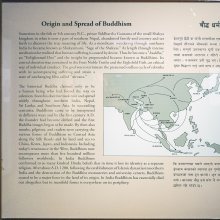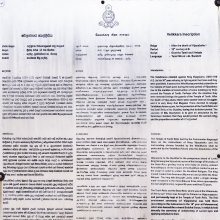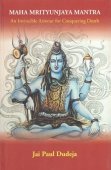Cause: 2 definitions
Introduction:
Cause means something in Buddhism, Pali, Hinduism, Sanskrit. If you want to know the exact meaning, history, etymology or English translation of this term then check out the descriptions on this page. Add your comment or reference to a book if you want to contribute to this summary article.
Images (photo gallery)
In Hinduism
Yoga (school of philosophy)
Source: ORA: Amanaska (king of all yogas): A Critical Edition and Annotated Translation by Jason BirchThe Cause (of the highest good) is denoted by the Sanskrit term Kāraṇa, according to the Amanaska Yoga treatise dealing with meditation, absorption, yogic powers and liberation.—Accordingly, as Īśvara says to Vāmadeva: “[...] Putting on ochre garments, carrying a skull, plucking out clumps of hair, maintaining non-vedic religious observances, ashes, ascetic clothing and matted locks, behaving as if mad, [the ascetic practice of] nakedness, [studying] the Vedas, Tantras and so on and the meeting [of learned people] for [reciting] poetry in the assembly: All [this] is exertion for the sake of filling one's stomach and is not the cause (kāraṇa) of the highest good. [na śreyasaḥ kāraṇam] [...]”.

Yoga is originally considered a branch of Hindu philosophy (astika), but both ancient and modern Yoga combine the physical, mental and spiritual. Yoga teaches various physical techniques also known as āsanas (postures), used for various purposes (eg., meditation, contemplation, relaxation).
In Buddhism
Theravada (major branch of Buddhism)
Source: Pali Kanon: Manual of Buddhist Terms and Doctrinescf. paccaya (1). - For the five c. of existence, s. paticca-samuppāda (10).
Theravāda is a major branch of Buddhism having the the Pali canon (tipitaka) as their canonical literature, which includes the vinaya-pitaka (monastic rules), the sutta-pitaka (Buddhist sermons) and the abhidhamma-pitaka (philosophy and psychology).
See also (Relevant definitions)
Starts with: Cause Effect, Causheri.
Query error!
Full-text (+9978): Karana, Hetu, Nidana, Nimitta, Hetuka, Karanika, Nimittakarana, Satkaryavada, Upadana, Ahetu, Samavayikarana, Naimittika, Sahetu, Karanakarana, Adikarana, Anyathasiddhi, Animitta, Jagatkarana, Prayojana, Karma.
Relevant text
Search found 616 books and stories containing Cause, Causes, The cause; (plurals include: Causes, Causeses, The causes). You can also click to the full overview containing English textual excerpts. Below are direct links for the most relevant articles:
Brahma Sutras (Nimbarka commentary) (by Roma Bose)
Brahma-Sūtra 2.2.19 < [Adhikaraṇa 3 - Sūtras 18-27]
Brahma-Sūtra 1.4.20 < [Adhikaraṇa 6 - Sūtras 19-22]
Brahma-Sūtra 2.2.33 < [Adhikaraṇa 6 - Sūtras 33-36]
Nyayakusumanjali of Udayana (study) (by Sri Ramen Bhadra)
Sāṃkhya view of cause < [Chapter 2 - The first and second Stavakas]
Summary of Arguments < [Chapter 2 - The first and second Stavakas]
Types of Śakti < [Chapter 2 - The first and second Stavakas]
Vakyapadiya of Bhartrihari (by K. A. Subramania Iyer)
Verse 3.3.62 < [Book 3 - Pada-kāṇḍa (3): Sambandha-samuddeśa (On Relation)]
Verse 3.1.25-26 < [Book 3 - Pada-kāṇḍa (1): Jāti-samuddeśa (On the Universal)]
Verse 3.9.108 < [Book 3 - Pada-kāṇḍa (9): Kāla-samuddeśa (On Time)]
Tattvartha Sutra (with commentary) (by Vijay K. Jain)
Verse 6.17 - The nature of Life-Karmas (leading to birth as a human being) < [Chapter 6 - Influx of Karmas]
Verse 6.23 - The nature of Auspicious Physique-making Karmas < [Chapter 6 - Influx of Karmas]
Verse 5.7 - Substances without-movement (niṣkriya) < [Chapter 5 - The Non-living Substances]
World Journal of Pharmaceutical Research
Causal study of postpartum hemorrhage after virginal delivery < [2019: Volume 8, July issue 8]
Understanding the Fishbone Diagram: A Tool for Root Cause Analysis < [2015: Volume 4, April issue 4]
Increased ratio of hysterectomies < [2019: Volume 8, October issue 11]
Maha Prajnaparamita Sastra (by Gelongma Karma Migme Chödrön)
Ninth comparison or upamāna: A reflection (bimba) in a mirror (ādarśa) < [Bodhisattva quality 19: the ten upamānas]
V. Value of the Buddha fields < [Part 4 - Assuring the continuity of the Buddha universes]
II. Attributes to be fulfilled (prāptukāma) and attributes to be cognized (jñātukāma) < [Part 1 - General questions]
Related products
(+66 more products available)









